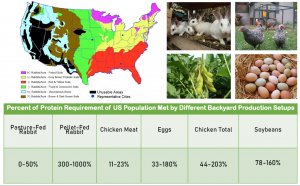Worried about access to meat because of shortages? New study: Use your backyard
The meat shortages cause many to wonder what to eat for protein when supply chains are disrupted. Some people turned to growing their own food.
HOUGHTON, MICHIGAN, UNITED STATES, June 17, 2021 /EINPresswire.com/ -- New research found that the work is well worth it. In a new study published in Sustainability, researchers looked at how a typical household with a typical backyard can raise chickens, rabbits or soybeans to meet its protein needs.As you know there have been food shortages and perhaps scariest the meat shortages. Also there have been weird runs on backyard gardening supplies and chicken coups as people grew concerned about our ability to produce food conventionally during the pandemic. It looks like we are heading out of this pandemic, but we hope we have learned some things to better prepare for the next one. To safeguard against meat supply shortages during pandemics or other catastrophes, this study analyzed the potential to provide the average household’s entire protein consumption using either soybean production or distributed meat production at the household level in the U.S. with: 1) pasture-fed rabbits, 2) pellet and hay-fed rabbits, or 3) pellet-fed chickens.
The findings are quite optimistic. The results showed that only using the average backyard resources, soybean cultivation can provide 80%-160% of household protein and up to 50% of a household’s protein needs can be provided by pasture-fed rabbits using only the yard grass as feed. If external supplementation of feed is available, raising 52 chickens while also harvesting the concomitant eggs or alternately 107 grain-fed rabbits can meet 100% of an average household’s protein requirements.
"Our results show that resilience to future pandemics and challenges associated with growing meat demands can be incrementally addressed through backyard distributed protein production." says Professor Joshua Pearce. Backyard production of chicken meat, eggs, and rabbit meat reduces environmental costs of protein due to savings in production, transportation, and refrigeration of meat products and even more so with soybeans.
Finally - generally, distributed production of protein was found to be economically competitive with centralized production of meat if distributed labor costs were ignored.
Joshua M. Pearce
MOST
email us here
Legal Disclaimer:
EIN Presswire provides this news content "as is" without warranty of any kind. We do not accept any responsibility or liability for the accuracy, content, images, videos, licenses, completeness, legality, or reliability of the information contained in this article. If you have any complaints or copyright issues related to this article, kindly contact the author above.

